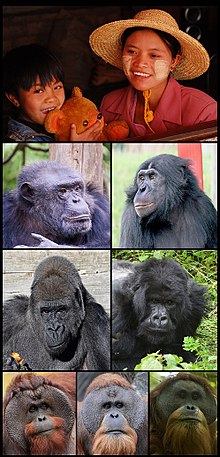
Back Hominidae Afrikaans Menschenaffen ALS Hominidae AN मानवनुमा ANP بشرانيات Arabic قرده عليا ARZ Hominidae AST Ayol (Hominidae) AVK Hominidlər Azerbaijani Гамініды Byelorussian
| Hominidae | |
|---|---|

| |
| The eight living Hominidae species | |
| Scientific classification | |
| Domain: | Eukaryota |
| Kingdom: | Animalia |
| Phylum: | Chordata |
| Class: | Mammalia |
| Order: | Primates |
| Suborder: | Haplorhini |
| Infraorder: | Simiiformes |
| Superfamily: | Hominoidea |
| Family: | Hominidae |

The hominids are members of the biological family Hominidae (the great apes). This family includes humans, chimpanzees, gorillas and orangutans.[2] "Great ape" is a common name rather than a taxonomic label, and people use it in different ways. Sometimes people mean to include humans in the category of “great apes,” and sometimes they mean non-human apes. Homo sapiens is definitely a hominid, as judged by all modern reference works.
Hominids range in weight from 48 kg to 270 kg. Males are larger than females. Hominids are primates with no tails, strong bodies, and well-developed forearms. Their thumbs (and big toes, except in humans) oppose the fingers, and form a grip. All digits have flattened nails.
At present, the family Hominidae includes four genera and eight species. However, if fossil hominids were included, all of the Australopithecines and the genus Homo would be members of the Hominidae family. Today, nonhuman great apes live only in the rainforests of equatorial Africa, Sumatra and Borneo.
The first hominid fossils are from the Miocene period. Archaeologists found these in Asia[3] and Europe. Also in Asia, they found fossils of a huge version of the orangutan called Gigantopithecus, which is now extinct. Fossils also show that Neanderthals were in Europe and western Asia for at least half a million years before modern humans appeared.
- ↑ Begun D.R; Nargolwalla M.C. and Kordos L. (2012). "European Miocene Hominids and the Origin of the African Ape and Human Clade". Evol. Anthropol. 21 (1): 10–23. doi:10.1002/evan.20329. PMID 22307721. S2CID 22792031.
{{cite journal}}: CS1 maint: multiple names: authors list (link) - ↑ Groves C. 2005. Wilson D.E.; Reeder D.M. eds. Mammal species of the world. 3rd ed, Baltimore: Johns Hopkins University Press. pp. 181–184. ISBN 0-801-88221-4. [1] Archived 2011-02-04 at the Wayback Machine
- ↑ Hill, Andrew & Steven Ward 1988. Origin of the Hominidae: the record of African large hominoid evolution between 14 My and 4 My. Yearbook of Physical Anthropology 31 (59): 49–83.[2]